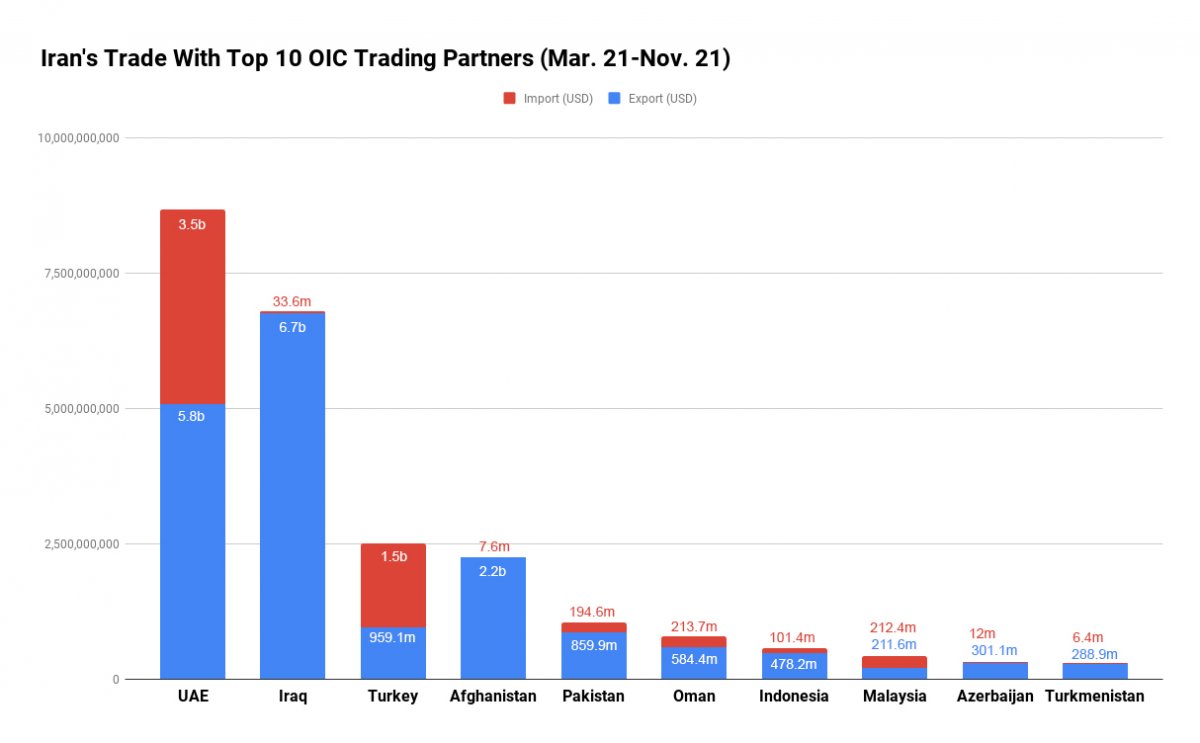This registers a 5.3% and 8.4% growth in tonnage and value respectively compared with last year’s corresponding period, the latest data released by the Islamic Republic of Iran Customs Administration show.
Iran’s exports to OIC member countries totaled 41.62 million tons worth $18.46 billion during the period, indicating a 12.86% and 31.5% increase in tonnage and value respectively year-on-year. Imports stood at 3.32 million tons worth $6.09 billion, down in tonnage and value by 30.14% and 29.56% respectively YOY.
OIC is an international organization founded in 1969, consisting of 57 member states, including Iran, with 47 countries being Muslim majority countries. Some, especially in West Africa, have large Muslim populations, but not necessarily Muslim majority countries, according to Financial Tribune.
The organization states that it is the collective voice of the Muslim world and works to safeguard the interests of the Muslim world for promoting international peace and harmony.
Since Syria has been suspended from the organization since August 2012, it was not included in the report.

Main Commodities and Top Partners
Iran mainly exported gas condensates, low-density oils, liquefied natural gas, mineral oils, hydrocarbons, semi-finished iron/non-alloy steel products, bitumen, iron/non-allot steel ingots, floorings and iron/steel bars to OIC members.
In exchange, major commodities imported into Iran from these countries included cellphones, semi-milled rice, wholly-milled rice, butter, steam turbines parts, cooking bananas, boneless frozen cow parts, vehicles and palm oil.
In terms of trade value, the UAE topped the list among OIC countries with bilateral trade standing at 12.64 million tons worth $8.68 billion, down by 12.2% and 9.06% in tonnage and value respectively YOY.
In fact, the UAE was Iran’s second biggest trading partner during the eight months under review after China.
However, a major part of Iran's trade with the UAE pertains to reexports of goods to third countries. These commercial exchanges are mainly made through the ports of Dubai, including Jebel Ali Port.
The UAE was the top exporter of goods to Iran followed by Turkey, Oman and Malaysia. It was Iran’s third export destination and the second biggest exporter of goods to Iran.
Exports to the UAE amounted to 11.06 million tons worth $5.09 billion to register a 5.68% decline in tonnage and 26.08% increase in value YOY.
In return, the UAE exported 2.79 million tons of commodities worth $4.45 billion to Iran, down by 28.31% and 29.63% in tonnage and value respectively YOY.
Major Iranian commodities exported to the UAE were gas condensates, low-density oils, mineral oils, liquefied hydrocarbons, copper cathode and iron/non-alloy steel ingots.
The UAE mainly exported cellphones, butter, steam turbines parts, turbojets parts, frozen boneless cow parts and machinery to Iran.
Iraq was Iran’s top export destination after the UAE, Afghanistan, Turkey and Pakistan.
The neighboring country is, in fact, the biggest market for Iranian products in the world.
The neighboring country was Iran’s second trading partner among OIC member states during the eight months. Two-way commercial exchanges stood at 14.27 million tons worth $6.79 billion, registering a 65.56% and 65.03% growth in tonnage and value respectively YOY.
Iraq was Iran’s third biggest trading partner in the world during the period. Iran exported 14.21 million tons of goods worth $6.75 billion to the country, up by 66.14% and 66.59% in tonnage and value respectively YOY. Iran’s exports to Iraq included liquefied natural gas, mineral oils, iron/steel bars, household cleaning detergents, floorings, low-density oils and tomatoes.
This is while Iran imported 55,956 tons of commodities worth $33.65 million from Iraq during the same period, down 39.95% and 42.74% in tonnage and value respectively YOY. These commodities mainly included low-density oils, cans, battery waste, aluminum alloy and cellphones.
Iraq was the seventh major exporter of goods to Iran in OIC and 42nd exporter to Iran in the world.
Mutual trade between Iran and Turkey amounted to 2.05 million tons worth $2.5 billion, indicating a 59.33% and 28.93% decline in tonnage and value respectively YOY.
Turkey was Iran’s sixth trading partner in the world. Iran’s exports to Turkey reached 1.24 million tons worth $959.16 million, down 67.06% and 32.92% in tonnage and value respectively YOY, while Turkey’s exports to Iran recahed 812,090 tons worth $1.56 billion, down by 36.62% and 26.13% in tonnage and value respectively YOY.
Turkey was Iran’s fourth export destination as well as the second exporter of goods to Iran among OIC countries. It was also Iran’s sixth export destination and the seventh exporter to Iran in the world.
Non-alloy zinc, non-alloy aluminum, bitumen, urea, and polyethylene grade film were Iran’s main goods exported to Turkey, while Turkey exported cooking bananas, tobacco, fibers, cotton, and auto parts to Iran.
Afghanistan was the third biggest destination for Iran's non-oil goods as it imports stood at 3.92 million tons worth $2.24 billion, up 1.94% and 25.91% in tonnage and value respectively YOY from Iran
In fact, Afghanistan was Iran’s fourth export destination in the world.
Exported commodities to Afghanistan included low-density oils, floorings, iron/steel bars and hydrocarbons. Iran mainly imported sesame, plants, lead, oilseeds and cattle.

